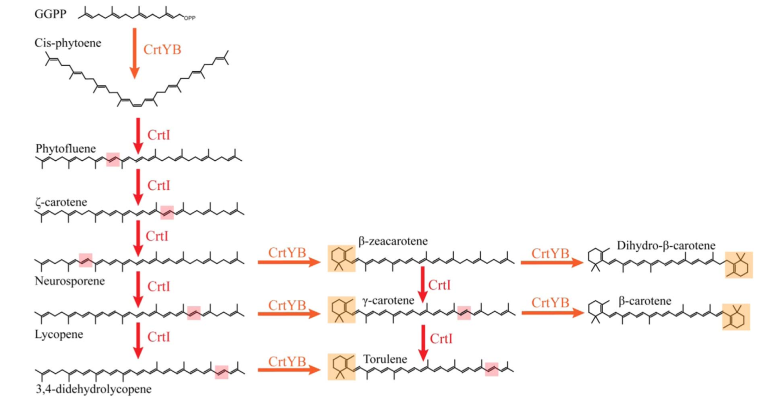Part:BBa_K3570011
CrtYB(ek)I - Tridomain fusion protein for β-carotene production in yeast
- 10COMPATIBLE WITH RFC[10]
- 12COMPATIBLE WITH RFC[12]
- 21INCOMPATIBLE WITH RFC[21]Illegal BglII site found at 2289
Illegal XhoI site found at 3868 - 23COMPATIBLE WITH RFC[23]
- 25COMPATIBLE WITH RFC[25]
- 1000INCOMPATIBLE WITH RFC[1000]Illegal BsaI site found at 1068
Illegal BsaI site found at 3193
Illegal BsaI.rc site found at 1399
Illegal SapI site found at 2593
Usage
Nowadays, the supplement of food in vitamins is done routinely. New biotechnological processes are developed in order to allow cheaper, faster, and more accessible production of vitamins. The functional goal of this part is to enrich Saccharomyces Cerevisiae in β-carotene.
The biosynthetic pathway from geranylgeranyl diphosphate (GGPP) to β-carotene consists of only two enzymes CrtYB and CrtI from Xanthophyllomyces dendrorhous. These enzymes have other enzymatic activities which lead to multiple side-products on the way to β-carotene (fig. 1). Side-products are synthesized mainly because CrtYB and CrtI are spatially distant from each other. CrtYB is a transmembrane protein while CrtI is in the cytosol. Fusing CrtYB and CrtI would allow a higher yield of β-carotene production. See “Biology” part to get more details.
Biology
Biosynthesis of β-carotene in X. dendrorhous begins with the production of phytoene from GGPP by the domain B of bifunctional lycopene cyclase/phytoene synthase (CrtYB). Phytoene desaturase (CrtI) then catalyzes four successive desaturation reactions to form lycopene. In the end, the domain Y of CrtYB performs the cyclization on both sides of lycopene to produce β-carotene (fig.1).

Eukaryotic CrtY enzymes are predicted to be transmembrane proteins. On the contrary, CrtB and possibly CrtI are supposedly cytosolic (Schaub et al., 2012). Additionally, in some fungi, the phytoene CrtY and CrtB catalytic activities are fused within a multidomain protein named CrtYB in Xanthophyllomyces dendrorhous (Verdoes et al., 1999). The complete biosynthetic pathway of X. dendrorhous, with a multidomain CrtYB, was efficiently expressed in S. cerevisiae (Verwaal et al., 2007). Even though this heterologous system is the most productive to date, the accumulation of β-carotene precursors in the pathway, such as phytoene, was remarked. Nevertheless, the overexpression of CrtI to overcome the metabolic bottleneck turned out to be only partially successful (Verwaal et al., 2007).
Recently, the natural tridomain fusion (CrtIBY) from Schizotrium sp. was expressed in Yarrowia lipolytica (Gao et al., 2017) but unfortunately, the β-carotene production yields were considerably lower than those obtained with the yeast-expressed X. dendrorhous configuration (Verwaal et al., 2007; Xie et al., 2015). We then searched to design an enzyme(s), that would have at the same time high production yields of β-carotene precursors (as in X. dendrorhous) with the spatial proximity of both cytosolic enzymes (CrtB and CrtI).
A strategy for creating an enzyme that would have crtYB et crtI activities and every listed property above was adapted from Rabeharindranto, H et al., 2019. This way, a tridomain fusion protein CrtYBekI was expressed in S. cerevisiae, with ‘‘ek’’ being a peptidic linker. This spatial reorganization of the carotenoid enzymes should reduce the accumulation of intermediates and reorient the metabolic fluxes towards β-carotene production.
Experiments
Team iGEM Toulouse 2020 did not have sufficient time to complete the cloning and hence, to test this part functionality.
Related parts on registry
There is a certain number of parts, already present on the registry, that are corresponding to single-enzymes such as CrtI (BBa_K2407309), CrtYB (BBa_K2407311, BBa_K530000) or CrtY (BBa_K539119, BBa_J29030, BBa_I742154, BBa_K118008). The main difference consists in the sequence of the proteins, which is taken from other organisms and are remarkably different. Also, the usage of protein of fusion as presented here, is believed to enhance the carotenoid production compared to the usage of two enzymes separately (Rabeharindranto, H et al., 2019).
References
- Rabeharindranto, H., Castaño-Cerezo, S., Lautier, T., Garcia-Alles, L. F., Treitz, C., Tholey, A., & Truan, G. (2019). Enzyme-fusion strategies for redirecting and improving carotenoid synthesis in S. cerevisiae. Metabolic Engineering Communications, 8, e00086
- Schaub, P., Yu, Q., Gemmecker, S., Poussin-Courmontagne, P., Mailliot, J., McEwen, A.G., et al., 2012. On the structure and function of the phytoene desaturase CRTI from Pantoea ananatis, a membrane-peripheral and FAD-dependent oxidase/ isomerase. PLoS One 7, e39550.
- Verdoes, J.C., Krubasik, P., Sandmann, G., Van Ooyen, A.J.J., 1999. Isolation and functional characterization of a novel type of carotenoid biosynthetic gene from Xanthophyllomyces dendrorhous. Mol. Gen. Genet. MGG 262, 453–461.
- Verwaal, R., Wang, J., Meijnen, J.-P., Visser, H., Sandmann, G., Berg, J.A. van den, et al., 2007. High-level production of beta-carotene in saccharomyces cerevisiae by successive transformation with carotenogenic genes from xanthophyllomyces dendrorhous. Appl. Environ. Microbiol. 73, 4342–4350.
- Gao, S., Tong, Y., Zhu, L., Ge, M., Jiang, Y., Chen, D., et al., 2017. Production of βcarotene by expressing a heterologous multifunctional carotene synthase in Yarrowia lipolytica. Biotechnol. Lett. 39, 921–927
- Xie, W., Ye, L., Lv, X., Xu, H., Yu, H., 2015. Sequential control of biosynthetic pathways for balanced utilization of metabolic intermediates in Saccharomyces cerevisiae. Metab. Eng. 28, 8–18.
Characterisation
| None |
